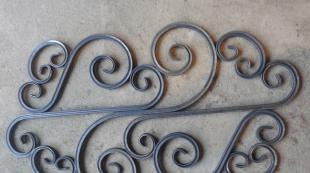School Encyclopedia. The Pergamon Altar - an amazing story Are temples built on the throne of Satan
The most outstanding exhibit of the antique collection is pergamon altar after whom the museum is named. The altar is decorated with a grandiose frieze depicting the battle of the gods with the giants.
This is what the Pergamon Altar looks like in the museum hall (photo from Wikipedia)
Around 180-159. BC e. Marble. Altar base 36.44 × 34.20 m
What is this altar, why is it called that and how did it get into the museum in Berlin? That's what I wanted to find out after I saw it with my own eyes. The Internet and Wikipedia helped me with this.
Pergamon- an ancient city off the coast of Asia Minor (now the territory of Turkey), former center influential state of the Attalid dynasty. Founded in the 12th century. BC e. immigrants from mainland Greece.
Here is a very interesting article by N.N. Nepomnyashchy about how this city was formed, what it was like and what happened to it. http://bibliotekar.ru/100velTayn/87.htm
In memory of the great victory over the barbarian tribe, which was called the "Galatians" (in some sources - the Gauls), the Pergamos erected in the middle of their capital city of Pergamum the altar of Zeus - a huge marble platform for sacrifices to the supreme god of the Greeks.
The relief, which surrounded the platform from three sides, was dedicated to the battle of gods and giants. The giants, as the myth said - the sons of the goddess of the earth Gaia, creatures with a human body, but with snakes instead of legs - once went to war against the gods.
The sculptors of Pergamum depicted on the relief of the altar a desperate battle between gods and giants, in which there is no room for doubt or mercy. This struggle between good and evil, civilization and barbarism, reason and brute force was supposed to remind posterity of the battle of their fathers with the Galatians, on which the fate of their country once depended.
In Pergamon, this structure was located on a special terrace on the southern slope of the acropolis mountain, below the sanctuary of Athena. The building consisted of a plinth raised on a five-step foundation, in the western side of which an open staircase 20 m wide was cut. The building of the altar, measuring 36 × 34 m, rested on a four-stage base and reached about 9 m in height. A relief frieze 2.30 m high and 120 m long covered the high smooth wall of the plinth and the side walls of the stairs. A jagged cornice completed the upper edge of the frieze.
The legend tells how the giants, the sons of the goddess of the earth Gaia, once decided to attack Olympus and overthrow the power of the gods. According to the oracle, the gods could win this fight only if a mortal man came out on their side. Hercules, the son of the god Zeus and the earthly woman Alcmene, is called to participate in the battle.
The large frieze of the Pergamon Altar impresses not only with its grandiose scale and colossal number of characters, but also with a very special compositional technique. The extremely dense filling of the surface of the frieze with high-relief images, leaving almost no free background, is a remarkable feature of the sculptural composition of the Pergamon Altar. The creators of the altar seemed to be trying to give the picture of the combat of the gods and giants a universal character, throughout the frieze there is not a single segment of the sculptural space that is not involved in the active action of a fierce struggle.
The altar, with its famous frieze, was a monument to the independence of Pergamon. But the Pergamians perceived this victory deeply symbolically, as the victory of the greatest Greek culture over barbarism.
Here is how M.L. Gasparov describes these events in his book "Entertaining Greece":
It was an impregnable city on a steep mountain, where once King Lysimachus laid down his treasures and left with them a faithful man from the Attalid family. Lysimachus died, the Attalids became the princes of Pergamon, they built it with beautiful temples and porticos for Lysimachov's money, they opened the second library in the world with its parchment books. The riches of Pergamon haunted the Gauls: they went to war against Pergamon and were defeated by Prince Attalus. And this victory was immortalized in a royal way: the son of Attalus, Eumenes, erected an altar of unprecedented size in Pergamon with the inscription "To Zeus and Athena, the giver of victory, for the favors received." It was a building half the size of the Parthenon; on top there was a colonnade surrounding the altar, to which a staircase led twenty steps high and twenty steps wide, and below there was a relief frieze, the height of a man, enveloping the building with an endless strip, and this frieze depicts the same that was woven on the cover of the Parthenon Athena , - the struggle of the gods with the giants, the victory of a rational order over an unreasonable element. Here arms are clashed, bodies are bent, wings are stretched, snake bodies are wriggling, faces are distorted by flour, and powerful figures of Zeus, throwing lightning, and Athena, plunging the enemy, loom among the crowded bodies. Such was the Pergamon altar - all that remains to us from the Gallic invasion.
This fragment of the frieze depicts Athena's struggle with Alcyoneus
.
(Fragment of the eastern frieze of the Pergamon altar).
Athena is the daughter of Zeus. The inscription on the cornice tells us her name. The goddess is dressed in a wide peplos, girded with two snakes. An amulet with the head of the Gorgon Medusa, which drives away evil forces, is placed on the left chest of Athena. Armed with a large round shield, she holds it so that we can see it. inner side. The goddess entered into a fight with the winged giant - Alcyoneus, grabbed him by the hair and tries to tear him off the ground, in contact with which he draws strength. Tormented by unbearable pain, the young man stretches out his left arm and left leg towards his mother, Gaia. With eyes full of sorrow, she begs Athena to spare her beloved son. But the snake has already sunk its deadly teeth into the body of a giant, and the goddess of victory Nike is already flying to Athena and crowning her with a laurel wreath.
These are fragments of the frieze of the altar, which I photographed in the museum
What happened to the altar of Zeus in Pergamon?
Anastasia Rakhmanova wrote about this in the magazine No. 11 "Around the World" for November 2006:
The kingdom of Pergamon fell, the temples were destroyed, the frieze was broken.
For more than one and a half thousand years, its fragments lay in clay soil near the city of Pergamum (modern Bergama) in Turkey. Local residents slowly dug out pieces of old marble to burn them for lime in chalk stoves. And in 1878, an expedition of German archaeologists led by engineer Karl Human arrived in Pergamon. For several seasons of excavations, she removed the powerful columns of the ancient temple from underground. The broken pieces of the frieze - the arms, legs, heads and tails of the titans - were piled into wooden boxes and sent to Berlin. Moreover, as the Germans do not get tired of repeating, with the personal permission of the then Sultan.
By the way, while scouring various sites in order to better understand what exactly I saw in the Pergamon Museum, I found that the parchment also comes from Pergamon, and here is a little about it from the site
http://maxbooks.ru/parchment.htm
Parchment is a writing material made from dressed animal skin, usually calf, sheep or goat.
In the production of parchment, the skin was not tanned, but carefully cleaned, scraped and dried under stress, obtaining sheets of thin and durable skin of white or yellowish color.
Although dressed animal skin has been used for writing before, the invention of parchment is usually associated with the name of the king of Pergamon, Eumenes II (197-159 BC). According to the historian Pliny, the Egyptian kings, wishing to maintain the prestige of the Library of Alexandria, banned in the 2nd century. BC e. the export of papyrus outside of Egypt, and the Pergamon Library, the second largest library ancient world it was necessary to develop an alternative option for the production of material for writing and improve the ancient methods of processing the skin. Thus parchment became an alternative to papyrus not only in Pergamum but throughout the Mediterranean, the main material for books in the Middle Ages, and continued to be used even after the invention of printing in the mid-fifteenth century.
And Wikipedia states that the altar was destroyed by an earthquake.
The Galatians were a warlike Celtic tribe that invaded Asia Minor from Europe. The mighty Syrian kings, who considered themselves the heirs of Alexander the Great, preferred to pay tribute to the Galatians, rather than take the risk of battle. The hordes of Galatians chose the small but very rich state of Pergamum as their next victim, which seemed to them a sure and easy prey. In terms of numbers, the Pergamon army was inferior to the troops of Syria of the Seleucids and Egypt of the Ptolemies, but in terms of technical equipment it clearly surpassed even them, not to mention the barbarian hordes of the Galatians. King Attalus I refused to pay tribute to the Celtic aliens. In the battle at the sources of Caik, the Pergamians utterly defeated the Galatians, after which Attalus took the cult name "savior". For some time, the small state became so influential that Attalus intervened in the struggle for the throne in the Seleucid kingdom and achieved some success in this endeavor.
The reason and civilization of the Pergamians prevailed over the superior numbers of the Galatians and the blind thirst for robbery. In memory of the great victory, the Pergamonians erected in the middle of their capital, the city of Pergamon, the altar of Zeus - a huge stone platform for sacrifices. Relief, with three sides surrounding the platform, was dedicated to the battle of the gods and giants. Giants - the sons of the goddess of the earth Gaia, creatures with a human body, but snakes instead of legs, according to myths, once went to war against the gods. The sculptors of Pergamum depicted on the relief of the altar a desperate battle between gods and giants, in which there is no room for doubt or mercy. This struggle of good and evil, civilization and barbarism, reason and brute force was supposed to remind the descendants of the battle of their fathers with the Galatians, on which the fate of their country once depended.
The figure of Zeus surpasses the rest in size and strength. His whole body, every muscle, is permeated with passion. Armed with lightning, the supreme god fights with three giants at once. One of them is turned sideways to the viewer, the other is frontal, the third, the main one - the leader of the giants Porfirion, turned his mighty back to the viewer. This is a worthy rival of Zeus, just as angry, just as hating. But if Zeus, like the rest of the gods, is a strong and beautiful person, then Porphyrion and the giants are carriers of rough, primitive, almost animal strength, stupid and also animal malice.
Near Zeus, his beloved daughter Athena is fighting. Grasping the hair of a young four-winged giant with her right hand, she tears him away from mother earth. The sacred serpent, Athena's inseparable companion, dug its teeth into the giant's body. The goddess Cybele, riding a lion, pursues a giant with an animal head. The sun god Helios tramples enemies with the hooves of his fiery horses. Hercules finishes off opponents with a club, and Phoebe acts with a heavy spear.
By the end of the 2nd century BC. e. Pergamon was conquered by the Romans. They took many sculptures from Pergamum, and the emperor Claudius took a library second only to that of Alexandria, and presented thousands of scrolls to Queen Cleopatra. And yet, until the VIII century, Pergamum continued to flourish, until it fell under the onslaught of the Arabs. Further destruction was continued by the Byzantines, who exported fragments of temples to Constantinople, and at the beginning of the 14th century Pergamum was captured by the Ottoman Turks, who turned it into ruins. The hordes of the lame Timur completed the defeat of the city in 1362, after which Pergamum ceased to be mentioned in historical chronicles.
Already in antiquity, the Pergamon altar began to acquire a halo of notoriety. The Apostle John the Theologian in his Revelation wrote: “And write to the Angel of the Church of Pergamon: thus says He who has a sharp sword on both sides: I know your deeds, and that you live where the throne of Satan is, and that you keep My name and have not denied My faith even in those days in which Antipas, my faithful witness, was slain among you, where Satan dwells."
In the 14th century after the 4th crusade For some time, the Pergamon altar allegedly became the object of worship of some secret neo-pagan sect, which operated in the depths of the spiritual and knightly order of the Hospitallers, better known as the Order of Malta. At this time, human sacrifices were allegedly performed on the altar.
In 1864, the Turkish government signed a contract with the German engineer Karl Humann to build a road from the small town of Bergamo to Izmir. Examining the site of future construction, the engineer noticed a steep rocky hill more than three hundred meters high on the eastern outskirts of the town. Climbing it, Humann discovered the remains of two rings of fortress walls. He managed to get the workers hired from the surrounding villages to build the road to talk. One of them stated:
Efendi! You can't dig here. White she-devils and red-haired devils live in the mountain. Allah has repeatedly punished those who mined a stone here. They would scab over and then be paralyzed. And the mullah punishes those who dig here.
Others have said:
At night, the disembodied spirits of pagan devils come out and arrange demonic dances. If they are disturbed during the day, as our grandfathers said, an earthquake will begin.
The mountain is magical, it hides the gods of a very ancient pagan country. Their curse over Bergamo has lasted for thousands of years. But if they are dug up and taken out, then our city will flourish again. I heard this in the mosque.
Humann realized that there had once been a city here. Historians forgot about him, but he continues to live in folk legends. After analyzing the stories of workers and historical works urgently ordered from Berlin, Humann came to a firm conviction: the hill hides ancient Pergamon with its famous altar. Having begun excavations, he, among other things, discovered parts of the relief picture of the altar, from which he gradually managed to restore the integral appearance of the Titanomachia.
The parts of the altar sent as a gift to the Berlin museums for the first time in a complete form with all the friezes and columns were put on public display in 1880 in a temporary building. It was visited by the great Russian writer Ivan Sergeevich Turgenev and spent hours looking at scenes of a fierce battle between gods and giants. The writer until the end of his life could not forget his deep delight. In his diary, Turgenev noted: "How happy I am that I did not die without living up to these impressions. I saw all this!"
The construction of the permanent building began only in 1912, and even by 1924 it was hardly even half finished. In the eventually built special museum, the altar of Zeus was displayed for 12 years - until 1941, when the Nazi authorities ordered it to be buried in damp clay soil under a military warehouse, which burned down during the next bombing of the German capital. In 1945, the Soviet occupation authorities took the Pergamon Altar to the USSR, but not as a trophy, but as an exhibit requiring urgent restoration, which was carried out by the Hermitage specialists. In 1958 the altar of Zeus returned to Berlin.
All this time, members of occult societies and frankly satanic sects showed keen interest in the restored monument of history and architecture. The altar was examined with interest by one of the leaders of the Golden Dawn of the Outer World secret society, Samuel Mathers, and a member of the same hermetic organization, the writer Mary Violetta Fet, who published under the pseudonym Dion Fortune. In the late 20s of the XX century, another adherent of the Golden Dawn, a magician and Satanist, the creator of the anti-Christian doctrine of "Thelemicism" Aleister Crowley, was also interested in the Pergamon Altar. Crowley himself did not see the altar, but on his instructions, Leah Hirag, known in occult circles as the Purple Whore, standing in front of the ancient shrine, mentally performed some secret rite designed to "release the vibes of the ancient natural gods."
A little later, the Pergamon Altar was subjected to a real invasion by German occultists from the O.T.O. - a society that had a significant impact on the formation of the occult world of National Socialism. Among them was a certain Martha Künzel, who for some time served as a liaison between German and British occult organizations. In the thirties, the famous neo-pagan Karl Maria Willigut, personal magician and mentor in the occult teachings of Reichsführer Heinrich Himmler, also examined the altar. The Pergamon altar generally seemed to attract close associates of the SS chief. For example, it was studied by Walter Darre, one of the founders of the Ahnenerbe Institute. Himmler's favorite journalist Helmut d'Alcuen, editor of the SS newspaper Black Corps, admired the altar as well. the dead leader of the world proletariat continued to live in a mystical way among the living.
Viktor BUMAGIN
#rainbow#paper#Countess#Dubarry
TO HOMENEWSPAPER RAINBOW
pergamon altar
The city of Pergamum (its ruins are located on the western coast of Turkey) was the capital of a small Hellenistic state in Asia Minor. The kings of Pergamum maintained ties with Athens and tried in every possible way to emphasize their respect for Athenian traditions. The goddess Athena became the main deity of Pergamum, and local rulers patronized the arts and competed with each other in patronage. By order of the kings of Pergamon, several outstanding works of ancient art were created, including the famous Pergamon Altar.
The grandiose white marble altar dedicated to Zeus and intended for worship in the open air was built in 180-160 BC. e. commissioned by King Eumenes II. The altar was erected in memory of the victory of the Pergamum king Attalos I over the invader at the end of the 3rd century BC. e. within the borders of his state by the tribe of the Galatians.
pergamon altar
The Pergamon altar was a high plinth on which rose a slender Ionic portico. On one side, the plinth was cut through by a wide open marble staircase leading to the upper platform of the altar, on which the altar was located. Along the perimeter of the plinth, the famous Great Frieze, 2.3 m high and about 120 m long, stretched in a continuous ribbon. Nowadays, the reliefs of the Great Frieze are stored in the Berlin Museum. Here you can also see a model-reconstruction of the altar.
The large frieze was made by a group of sculptors according to a single compositional plan. The names of some authors are known - Dionysiades, Orestes, Menekrates. It is difficult to say which of them made which part of the altar. The artists belonged to different areas of ancient Greek art and came from different schools. Some were representatives of the Pergamon style, others came from Athens, followers of the classical school of Phidias. But at the same time, the whole composition makes a holistic impression and not a single detail violates the unity of the artistic conception. The exceptional richness of the images and the enormous size of the frieze make it an outstanding work, which has no equal in ancient art.
The theme of the Great Frieze is Gigantomachy, the battle of gods and giants. This is an allegorical image of the struggle of the kings of Pergamon with the Galatians, in memory of which the Pergamon Altar was created. In the battle on the side of the gods, in addition to the deities of Olympus, a number of gods are very ancient or even invented by the authors. On the western side of the altar, the deities of the water element were depicted, on the southern side - the gods of heaven and heavenly bodies, on the eastern, main side - the Olympic gods, and on the northern side - the deities of the night and constellations.
Ancient Greek myths tell that the giants, the sons of the goddess of the earth Gaia, rebelled against the gods of Olympus and in a fierce battle - Gigantomachia - suffered a crushing defeat. Scenes of Gigantomachy unfold one after another on the frieze of the Pergamon altar. To emphasize that it is not just a battle, but a battle of two worlds - the upper and the lower, the masters depicted the gods over the figures of the giants. In total, the frieze depicts about fifty figures of gods, and the same number of giants. The figures are made in very high relief, they are separated from the background and are practically sculptures. The background between them is densely filled with fluttering clothes, wings of eagles and giants, writhing snakes. The details of the frieze are made and processed with such care that you literally feel their materiality.
Initially, all the figures were painted, many details were gilded. High relief gave deep shadows, as a result of which all the details could be clearly distinguished from a distance. The battle is depicted in full swing, the masters skillfully emphasized the furious pace of the unfolding events. The impetuous onslaught of the gods is opposed by the desperate resistance of the giants. Opponents are depicted in full growth, many giants have snakes instead of legs. The names of each of the gods and giants, explaining the images, are neatly carved below the figures on the cornice.

Fragments of the frieze of the Pergamon Altar
The central image of the frieze is the fighting Olympian Zeus. He simultaneously fights with three opponents. In his half-naked figure, boundless, inhuman power is felt. Having struck one of the opponents, Zeus the Thunderer prepares to throw his sizzling lightning at the leader of the enemies - the snake-legged giant Porfirion. The giant's muscles bulged in tension, his face contorted with bitterness as he prepares to parry the blow.
The scene of the battle between the goddess Athena and the winged giant Alcyoneus is filled with special drama and expressiveness. The goddess with a shield in her hands plunged the enemy to the ground, her movements show through the decisiveness and triumph of the winner. The winged goddess of victory Nike rushes towards her to crown Athena's head with a laurel wreath. The defeated giant tries in vain to free himself from the merciless hand of the goddess. His muscles are tense in the last effort, his face expresses deep suffering. The sacred snake of Athena, wrapped around the giant, digs into his chest ... Next to Athena, the figure of the goddess of the earth Gaia, the mother of giants, rises mournfully. Her arms are up, her long hair flowing over her shoulders. The sculptors succeeded with unusual drama in conveying the grief of a mother mourning her sons.
On the upper platform of the Pergamon altar there was a second frieze - a small one. It is dedicated to the myth of Telephos, an Arcadian hero who was revered in Pergamon. This frieze was performed in a completely different style than the Bolshoi. The unhurried movement of the actors, the calm landscape against which the events unfold, serve as a contrast to the tense, dynamic images of the Great Frieze.
In terms of its artistic and historical significance, the Pergamon altar is on a par with the Parthenon. This is one of the most majestic buildings in Hellas, at the same time being one of the unsurpassed pinnacles of world art.
From the book Here Was Rome. Modern walks in the ancient city author From the book Here Was Rome. Modern walks in the ancient city author Sonkin Viktor Valentinovich From the book Unknown Russia. A story that will surprise you the author Uskov NikolayAt least give us a bear on the altar The fate of Nikon, who became an instrument of great Russian politics, mistakenly believing that he was raised to his heights by God himself, is indicative. Nikon used the title of "great sovereign", who, of all the primates of the Russian Church, had previously been
From the book Forgotten Jerusalem. Istanbul in the light of the New Chronology author3.5. Why does the synodal translation of the Bible rename the altar to davir, and the kiot - to the ark? In the modern synodal translation of the Bible, when describing Solomon's temple, the words DAVIR and ARK (1 Kings 6-7) are often used. They give the reader the impression that it is talking about
author Ionina NadezhdaThe golden altar of St. Mark's Cathedral Initially, St. Theodore was considered the heavenly patron of Venice, but in the 9th century this Byzantine saint was replaced by the Latin St. Mark. Then a legend arose about this change. Returning from Aquileia, where he
From the book 100 great treasures author Ionina NadezhdaGhent altar in the Cathedral of St. Bavo In 1521, while traveling in the Netherlands, the German artist A. Dürer wrote in his diary about the reception he received in Ghent:
From the book 100 great treasures author Ionina NadezhdaAltar of St. Mary's Cathedral in Krakow The ancient Polish city of Krakow, founded around 700, was located at first on a small hill on the left bank of the Vistula, which divides the city into several parts. Krakow, like any other ancient city, has its own legend.
From the book The Conquest of America by Ermak-Cortes and the rebellion of the Reformation through the eyes of the "ancient" Greeks author Nosovsky Gleb Vladimirovich10.1. What is the "ancient" Pergamon Altar? Encyclopedia of Brockhaus and Efron reports the following. “PERGAMINE ANTIQUES. - These words usually mean the discovery at the end of the seventies of the current (XIX - Auth.) century of the ruins of the COLOSSAL ALTAR,
From the book Daily Life of the People of the Bible author Shuraki Andre From the book Evil cramp. Book 1. The Invisible Fire of Death the author Absentis DenisChapter 5 Altar of Ergotism - And I like to look at this picture! muttered Rogozhin after a pause. - To this picture! the prince suddenly exclaimed, under the influence of a sudden thought, “at this picture! Yes, from this picture, another may lose faith! - Disappears and that, - unexpectedly
From the book Poland against the USSR 1939-1950. author Yakovleva Elena ViktorovnaChapter 9 Russia brings down, and there is no rebuff to it! So no! We will destroy ourselves - Death is better than shame for us! "Damn the one who does not destroy himself!" And, thirsting for their own blood, They expect that their heads will immediately
From the book Secrets of Ancient Civilizations. Volume 2 [Collection of articles] author Team of authorsThe altar we miss Vadim Karelin In 29 BC. e. for the third time in Roman history, the doors of the temple of Janus were closed: the end came to last more than a hundred years civil wars. Warlike Rome knew only five short periods of peace during the first eight
From the book Archeology in the wake of legends and myths author Malinichev German DmitrievichAltar of Zeus After analyzing the stories of workers and historical works urgently ordered from Berlin, Humann came to a firm conviction: the hill hides ancient Pergamon with its famous altar. But where to start excavation? Once again, local workers helped. Behind
From the book Late Rome: Five Portraits author Ukolova Victoria IvanovnaChapter II. Struggle for the Altar of Victory: Quintus Aurelius Symmachus The death of paganism was not sudden. Its decline lasted for centuries, but by the time of Emperor Julian (361–363) it had already outlived itself both as a religious and as a political ideology. Politics of Julian, who sought to restore
From the book The Jewish Question to Lenin author Petrovsky-Stern JohananOn the altar of enlightenment In Starokonstantinov, nothing kept Moshko. He made a sudden but fortunate decision to move to Zhytomyr and settle there forever, although as a taxpayer he remained for a long time assigned to the Staro-Konstantinovsky kahal. Moshko decided
From the book Book 2. Development of America by Russia-Horde [Biblical Russia. The Beginning of American Civilizations. Biblical Noah and medieval Columbus. Revolt of the Reformation. dilapidated author Nosovsky Gleb Vladimirovich7.5. Why does the synodal translation of the Bible rename the altar to davir, and the kiot - to the ark? In the synodal translation of the Bible, when describing the temple of Solomon, the words DAVIR and the ARK are often used (1 Kings 6-7). They give the reader the impression that they are talking about something ancient.
No less rapidly than Alexandria of Egypt, other Hellenistic cities developed, especially those that had access to the sea. In Asia Minor, the city of Pergamum grew up, named so from the local word meaning "city". The hill on which he was located was on the banks of the navigable river Selinus. At the beginning of the IV century. BC. this hill was owned by a certain Gongil of Eretria, and after the conquest of Alexander, was in the power of a certain Phileter. Being a confidant of one of the commanders of Alexander, he managed to appropriate his treasury. This was enough for the city of Pergamum in Asia Minor, where the thief had established himself, to become the capital of a small kingdom. Phileter's successors inherited his skill. They skillfully maneuvered between powerful neighbors. A difficult test fell to their lot - the invasion of the barbarian hordes of Gauls, who created their own state next to them. At the cost of incredible efforts, they managed to be thrown back.
The king of Pergamon, Eumenes II, nicknamed the Savior for getting rid of the invasion of the Gauls, decorated the capital with marble colonnades and palaces to commemorate the victory. A monumental altar was erected on the western side of the city hill. Pausanias, unfortunately for art history, did not visit Pergamon. Only in the work of the late author Lucius Ampelius "Memorial Book" is there the only one in the whole ancient literature phrase referring to the altar: "In Pergamon there is a large marble altar 40 feet high, with powerful sculptures depicting the battle with the giants." In addition, a record of the Byzantine prince Theodore Laskaris, who visited Pergamon in the 14th century, has been preserved: “Everything here is full of royal grandeur, the walls, incomparable in their splendor, ascend to the bronze heavens.” This would be the limit of our information about one of the wonders of the world, if it were not possible to find the remains of the altar and its sculptural decorations.
Among the European archaeologists and art critics who have done a lot to study this outstanding monument of ancient art, Carl Humann (1839-1896) occupies the first place. He dreamed of becoming an architect and studied architecture at the Berlin Academy. Illness forced him to interrupt his studies and go on the advice of doctors to improve his health on the island of Samos (1861). In Constantinople, the vizier Fuad Pasha interested Humann in the project of building a new road through Western Asia Minor and gave him a responsible assignment to draw up its route. This led Humann in 1864 to the Turkish town of Bergama, which retained the name of the ancient capital of the Pergamon kingdom.
28 km from the Aegean Sea, at the confluence of the rivers Selinus and Ketios, a hill with picturesque ruins rose. Humannus was struck by the human figures swarming in them. They were workers who burned marble into lime. This place was the ruins of a Byzantine wall, partly built from the remains of an ancient frieze. Humann extracted several fragments from it and sent it to Berlin for research. Using his connections, Humann achieved the cessation of work and thus saved Pergamum from final destruction.
In 1871, a group of Berlin scientists visited the excavation site; among them was the famous archaeologist Ernst Curtius. Humann promised his colleagues to unearth a "Byzantine wall", partly composed of architectural and sculptural remains. One could count on interesting finds, but at that time no one assumed that parts of the Pergamon altar were in the wall.
Humann was able to start excavations only in 1878. Alexander Konze, director of the sculpture collection of the Berlin Museum, worked with him. The ancient "Byzantine wall", from which the study began, contained either whole slabs or fragments of a significant part of the huge frieze. By the end of 1878, Humann had removed 39 slabs. “We found a whole era of art. The greatest work of antiquity left at our fingertips!” wrote Human.
To understand the sequence of reliefs, it was important to find the foundation of the altar. This discovery was made in the same 1878 on the southern slope of the city hill. The foundation in its original form had an almost square shape (36.4 x 34.2). In its western side there was a staircase of 20 wide steps leading to the upper platform of the altar surrounded by columns.
The greatest interest among archaeologists was caused by 11 slabs located at the foundation. Carl Humann described their discovery as follows: “It was July 21
1879, when I invited guests to come with me to the acropolis to watch the inward-facing slabs being turned over. When we turned them over, seven huge eagles were spinning over the acropolis, it would seem, foreshadowing happiness. They knocked over the first slab. A mighty giant appeared on serpentine writhing legs, facing us with a muscular back, head turned to the left, with a lion's skin on his left arm. “Unfortunately, it does not fit any known stove,” I said. They took the second plate. A magnificent god, with his whole chest turned to the viewer. A cloak hangs from his shoulders, fluttering around his wide-paced legs. “And this stove does not fit anything I know!” The third slab depicts a lean giant who has fallen to his knees, his left hand painfully grabs his right shoulder, his right hand seems to have been taken away. Before he is completely cleared of the earth, the fourth plate falls: the giant pressed his back against the rock, lightning struck his thigh - I feel your closeness, Zeus! Feverishly, I run around all four plates. I see the third approaching the first: the snake ring of the big giant clearly passes to the slab with the giant who has fallen to his knees. The upper part of this slab, where the giant extends his hand wrapped in a skin, is missing, but it is clearly visible that he fights on top of the fallen. Is he fighting a big god? Indeed, the cloaked left leg disappears behind the kneeling giant. “Three fit together!” - I exclaim and stand already about the fourth: and she approaches - the giant, struck by lightning, falls behind the deity. I literally tremble all over. Here is another piece - with my nails I scrape off the ground: the lion's skin is the hand of a gigantic giant - against this scales and snakes - an aegis! It's Zeus! The monument, great, wonderful, was again presented to the world, all our works were crowned, the Athena group received the most beautiful addition. Deeply shocked, we, three happy people, stood around the precious find until I sat on Zeus and relieved my soul with large tears of joy.
Transportation of reliefs weighing up to 60 centners presented great difficulties, especially on a section of a narrow old road. Carl Humann, an experienced engineer, ordered to build something like a sleigh from long trunks and lay open treasures on them. There were other kinds of obstacles to deal with as well. According to Turkish laws, a third of the finds belonged to the owner of the site, a third to the state, and a third to the organizer of the excavations. It took considerable effort to persuade the Turkish government to sell its stake.
Yes, 97 stone slabs and 2000 fragments were sent to Berlin. The restoration work has begun. She showed that the highest Olympian gods occupied the eastern side of the altar, the daytime deities - the south, the gods of the night, constellations and the underworld - the north. Almost the entire western side was assigned to a wide entrance staircase. The signs of stonemasons on the slabs (letters of the Greek alphabet), and in some cases the names of the gods, helped to understand the sequence of reliefs.
In 1902, the building of the Pergamon Museum appeared in Berlin with a restored altar. In 1908, as a result of the settlement of the foundation, the slabs had to be removed, especially since at that time new fragments of the frieze became known, somewhat changing the idea of its composition. The new building of the Pergamon Museum was opened for viewing in 1930, but the exposition did not last long. In 1939 all Berlin museums were closed. War…
There is something symbolic in the fates greatest monument antique art. When the Allied aircraft dropped thousands of bombs on Berlin, the gods and giants took refuge in one of the dungeons near the Tiergarten. There they lay throughout the war, only occasionally shuddering from explosions. By the end of the war, when all of Berlin was a sea of ruins, the trophies were taken to where they were not in danger.
A few more years passed, and the hall of the Hermitage with the Pergamon frieze was opened for public viewing. It was a great event in the artistic life of our country. Perhaps, for the entire centuries-old history, the Pergamon frieze for the first time found spectators who could understand and appreciate his idea so well. Everyone who entered the hall found himself surrounded by restless marble figures. For a front-line soldier, this was like a battlefield, where even "the dead, before falling, take a step forward." The ancient relief seemed as modern a work of art as Shostakovich's 7th symphony, which arose during the years of the blockade. In this heap of bodies there was the same chaos and fragmentation, the same furious impulse and titanic sound.
With the transfer of ownership of the Berlin Museum to the government of the German Democratic Republic, a new chapter in the history of the Pergamon Altar begins - the restoration of the altar and the installation of the frieze. Since October 4, 1959, the Pergamon Altar Museum has been open to the residents of East Berlin and its guests.
The plot of the large frieze of the altar is monsters with snake bodies and sometimes with the heads of lions or bulls, the struggle of the gods with the giants. The giants, the sons of the Earth - Gaia, rebelled against the gods. The oracle promised victory to the gods if mortals were on their side. Therefore, Hercules acts as allies of the gods.
The east frieze depicts the battle of the Olympian gods with the giants. The heads of the combatants have not been preserved, but the expressiveness of powerful bodies conveys the superhuman tension of the struggle. The naked torso of Zeus is the personification of such infinite power that lightning strikes falling on the giants are perceived as its direct radiation. The leader of the giants, Porfirion, turned his mighty back to the viewer. This is a worthy rival of Zeus.
Equally dramatic is the episode of the battle involving Athena. Grasping the winged giant by the hair, the goddess plunges him to the ground. The giant's body is tensely curved, his head thrown back in unbearable torment. Wide eyes full of suffering. Gaia, the mother of the giants, rises from the earth and vainly begs Athena to spare her son. But the flying Nika is already crowning Athena with a victorious wreath.
On the south side of the east frieze, a three-headed Hecate with a torch, shield and sword fights against the giant Clytia. In impotent rage, the snake bites the shield of the goddess. To the right of this group is Artemis, the courageous hunter-goddess, attacking a heavily armed giant. Between them is another defeated giant with the body of a snake. Artemis' dog grabbed him by the neck. Defensively, he grabbed the animal's eye.
Behind Artemis is Latona, the mother of Apollo and Artemis. She turned her torch against the young winged giant, who, unable to withstand the swift onslaught of the goddess, fell. With one hand he convulsively supports his body, with the other he tries to take the torch away. In the thrown back head, in the expression of the face and eyes - a premonition of imminent death. Naked Apollo threw the giant to the ground. Apollo's head has not been preserved. But the jubilation of the winner is felt in the pose. Apollo's adversary is a bearded giant. In the expression of his face, one can feel surprise at the power of the enemy.
The plot of the northern frieze is a continuation of the scenes of the eastern frieze, ending with the image of the god of war Ares. His wife Aphrodite opens the northern frieze. Nothing says that this is the patroness of beauty and love. Before us is a formidable warrior who has taken her place in the ranks of the fighters. Her spear was lodged in the already dead giant's chest. By stepping on his face, the goddess tries to free her weapon. Aphrodite's mother Dione fights the young giant with the same fury. She is helped by the son of Aphrodite, the winged Eros.
Part of the northern frieze is occupied by the image of the goddess in peplos and mantle. In her raised right hand a vessel from which a snake protrudes. With her left hand, she grabbed the edge of the shield, which covers the helmeted bearded giant. The majestic and courageous appearance of the goddess made it possible to see in her the goddess of the night Nikta, revered by Zeus himself.
To the right of Nikta is her daughter Moira. In myths, these are decrepit old women spinning the threads of human destinies. Here are the young warriors who surrounded the bearded giant. He no longer hopes for salvation. There is hopelessness and horror in his face. To the right of the moira is a perfectly preserved figure of an unknown goddess. Her long hair falls in waves over her shoulders. Together with the goddess, the lion fell on the giant and tormented him with fangs and claws. Behind the goddess with a lion is the team of Poseidon, the god of the seas. Pitiful fragments have been preserved from it.
Poseidon reveals a series of sea deities, the continuation of the image of which we find on the western frieze. First of all, we see the god of the waves, Triton, with a human face and upper body, a dolphin's tail and hooves instead of legs. Triton fights three giants at once. One of them has already been thrown to the ground, the other has fallen on his left knee, the third is protected by a lion's skin. In the same group of sea deities, Poseidon's wife Amphitrite and her parents Nereus and Dorida. Dorida grabbed the young giant by the hair and stepped on his serpentine tail. Following the enemy of Dorida, two giants can be seen pursued by the Ocean.
In the continuation of the western frieze behind the stairs, the gods of the circle of Dionysus are depicted. The god of vegetation and wine is accompanied by two young satyrs and a goddess in a long robe, walking behind a lion. It is believed that this is Nisa, the nurse of Dionysus.
None of the works of the era, which began with the eastern campaign of Alexander the Great, reflects its spirit better than the Pergamon altar. Passion and intoxication with the struggle, which makes compassion and pity impossible, permeate every figure. In the giants who entered into a hopeless struggle with the gods, the Pergamians could see their courageous opponents of the Galatians. But equally, they could believe that under the guise of giants, the supporters of Aristonicus, who raised the fight against Rome, or the soldiers of Mithridates VI Eupator, who at one time owned Pergamum, are depicted. Both that, and another, and the third interpretation do not exclude each other. The altar is an artistic embodiment of the tragedy of wars, including popular riots and rebellions, which are so rich in the history of antiquity. The idea of the frieze is the victory of the forces of order over the rebellious elements, ready to destroy the mind and the boundaries of the universe, destroy the divine harmony, plunge the world into chaos.
The theme of patriotism, the defense of one's native country or city from invaders is found in works of world art with enviable constancy. The famous Pergamon Altar, or the Altar of Zeus, built by the citizens of the city of Pergamon in the first half of the 2nd century BC, is no exception. BC. in honor of their victory over the Galatians (Gauls).
Pergamon altar - an ode to courage and valor
The ancient city of Pergamum, now located in Turkey, was the capital of the Pergamon kingdom and one of the centers of Hellenistic culture. It is believed that it was here that parchment was invented - the main material from which books were made in the Middle Ages. From the name of the city, as you probably noticed, the word "parchment" itself came from. Pergamon would have become valuable booty for the Galatians, a united alliance of Celtic tribes who invaded Asia Minor. But he didn't become one. The Pergamons, under the leadership of their king Attalus the First, defeated the invaders, although the latter had a numerical advantage. In honor of the victory, the townspeople erected a marble altar to the main Olympic god Zeus.
city of Pergamon. Source: wikimedia.org
For those times, the altar was something unheard of, and today it is also very impressive. The fact is that this is not just a table for sacrifices, but a full-fledged architectural structure. A high staircase led to covered galleries with Ionic columns, elongated in the shape of a P. Inside the galleries there was an altar courtyard with an altar, statues stood on the roof, and a small frieze (horizontal decorative composition) with scenes of the myth of Telephos, the son of Hercules and the legendary founder of Pergamum, was placed on the walls of the courtyard.
Just imagine: the altar itself reached 9 m in height, and the large frieze, located along the perimeter of the plinth, was 120 m in length.
The reliefs of the large frieze, on which a whole group of sculptors worked, including Dionysiades, Orestes, Menekrates and others, depict gigantomachia, that is, the battle of the gods and titans, and they are the main decoration of the altar.
The intense battle of the gods and titans clashed in battle is a metaphorical depiction of the battle of the Pergamians with the Galatians. Of course, the Pergamians associated themselves with the victorious Olympian gods, and the Celtic tribes with the Titans who rebelled against them, the sons of the Earth, who had the torso of a man and writhing snakes instead of legs. This is, if you will, a struggle between culture and barbarism, light and dark forces.
Schematic of the altar. Source: wikimedia.org
Composition of symbols in the decoration of the altar
The reliefs of the Pergamon altar represent a single whole: before us is an interweaving of curving tense bodies, between which there are no large gaps. Our eyes wander, fascinated by these movements flowing one into another, unable to stop at any particular figure - there are many characters, and it is not clear whether there is a dominant one. In the Pergamon Altar, everything moves, breathes and connects.
Consider one of the most famous fragments. On it are four figures: Athena, Gaia, Nike and the giant Alcyoneus. In the center of the composition is Athena. Grabbing the giant by the hair, she carries out the massacre. Alcyoneus seems to be torn between Athena holding him tightly, Gaia, to whom he stretches his hand, and the serpent, Athena's faithful companion, firmly wrapped around the body of the winged giant. Alcyoneus and Gaia cannot touch each other - the mother is unable to help her son, which is hinted at by the soaring Nike, the goddess of Victory. The emotional and physical drama is emphasized by the incredible curve of the giant's body: from the wings to the left leg, it forms a semicircle. His muscles are unnaturally tense, his head is thrown back in despair, even the locks of his hair are writhing like snakes. Alcyoneus' eyes are raised to the sky, his mouth is parted, as if for a dying breath.
Wolfgang Sauber / wikimedia.org
Wanderings of the Pergamon Altar between Germany and the USSR
By the way, a curious fact - after the Second world war Soviet troops occupied Berlin, they took with them many works of art, including the Pergamon Altar stored there in a museum specially built for it. It needed restoration, which was superbly done by our specialists. For thirteen years it was kept in the Hermitage, and only in 1958 did Khrushchev return the altar to Germany of his own free will.
And before that, by agreement with the German side, a plaster cast was made from the work, which we can still admire today within the walls of the Art and Industry Academy. A.L. Stieglitz in Petersburg.
Since the cast appeared at the academy, fragments of the altar have been painted countless times, because this is part of the training program for future artists.
As we know, houses and walls help. The Pergamonians managed to defend their city, despite the huge numerical superiority of their opponents. How many times in history has this happened? Not so many, but still enough examples. He who defends his home and hearth has superiority over his opponent, no matter how strong the latter is. It seems that these ideas were the inspiration that made it possible to create a magnificent monument full of dynamics and dramatic pathos that never ceases to amaze us even after two thousand years.
Jan Mehlich / wikimedia.org
If you find an error, please highlight a piece of text and click Ctrl+Enter.









